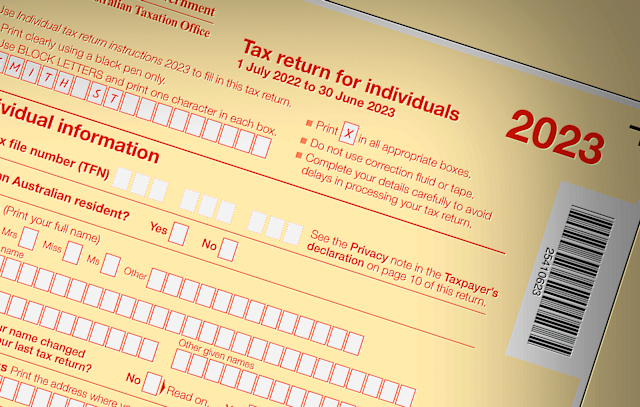Why do I suddenly owe tax this year?
This is one of the most Googled questions in Australia right now. And rightly so.
Ever since Australia’s transition to self-assessment for income tax returns, we have been primed to expect an annual refund.
That’s by design. Thinking we will get a refund acts as an incentive to get us to fill in the form.
But it’s actually not a good thing to get a refund. Bear with me. Refunds mean the Tax Office has been holding onto our money.
Nevertheless, many of us would really, really like a big refund this year.
Read more: Does paying for tax advice save money? Only if you’re wealthy
Abysmal wage growth, rapidly rising living costs, a housing affordability crisis and the fastest tightening of interest rates in 30 years have been putting us under the most financial pressure in years, and (given known associations) quite likely harming our mental health.
However, two changes this year mean our refunds are likely to either be much smaller than before, or to vanish altogether and be replaced with tax bills.
One of the changes is to rules governing how working-from-home expenses are calculated. You can read about it here.
The other, the focus of this piece – and it applies to many more people – is the end of the A$11 billion Low and Middle Income Tax Offset, known as LMITO.
LMITO was for higher rather than lower earners
Worth up to $1,500 per taxpayer in 2022, and paid or part-paid to taxpayers who earned between $37,000 and $126,000, LMITO was introduced in 2018 as a temporary measure by then treasurer Scott Morrison to “increase disposable incomes to help relieve household budget pressures”.
Taxpayers earning between $48,000 and $90,000 got the maximum, which began at $1,080 in 2019 and climbed to $1,500 in 2022.
“Low and Middle Income Tax Offset” was a misnomer. The benefit wasn’t available to really low earners (who were eligible for a separate offset) and it was available to people who earned a good deal more than middle incomes.
The median (middle) income in tax returns filed for 2020-21 was $62,600.
A taxpayer on $90,000 and eligible for full LMITO would be in the top 28% of earners. A taxpayer on $126,000 and partly eligible would be in the top 13%.
‘Temporary’, then extended, then extended again
Morrison always intended LMITO to be temporary because it was to be replaced in 2022 by measures in Stage 2 of his tax cut plan that would have the same effect.
But in the 2020 budget, Treasurer Josh Frydenberg brought forward Stage 2 from 2022 to 2020 and kept LMITO in place to provide an “additional benefit”.
In 2021 Frydenberg extended LMITO for yet another year to give recipients what he called a “further benefit” that would help secure the economic recovery.
In 2022 Frydenberg stopped. The benefit for 2021-22 to be paid out in 2022 would be the last, although it would be boosted from $1,080 to $1,500 as a “temporary, targeted and responsible way to reduce cost of living pressures”.
Now its gone, tax bills are $1,500 higher
The benefit’s design, being paid out at the end of each tax year rather than through the year, meant that when it went, it would be noticed.

If there would have otherwise been a tax bill, it would be up to $1,500 bigger. If there would have otherwise been a tax refund it would be up to $1,500 smaller – enough to turn many tax refunds into tax bills.
That’s what’s happening now. More than 10 million Australians received LMITO in its final year, most of them the full LMITO.
That means millions who have submitted their forms this year are getting bills in place of refunds, and millions more are getting refunds that are smaller or bills that are bigger.
Treasurer Jim Chalmers could have saved the benefit – in April Shadow Treasurer Angus Taylor accused him of trying to hide a decision to axe it “under the cover of Easter”.
But the decision to end it was taken a year earlier in Frydenberg’s budget for the 2022-23 tax year, meaning it is only now being felt.
A flawed idea, at odds with advice
Offsets aren’t an ideal way to deliver tax support. Those that are means-tested (like LMITO) distort effective marginal tax rates. Those that are paid out at the end of each tax year (like LMITO) withhold support at the time it is needed.
The 2009 Henry Tax Review wanted most offsets removed and replaced with either direct payments or changes to the tax scales.
Its preferred model was a fairly flat tax scale with a high tax-free threshold of $25,000, meaning an extra 10% of taxpayers would pay no tax. At today’s wage rates that would be a tax-free threshold of $36,000, freeing 1.3 million taxpayers from the need to pay tax.
Where to from here?
Assuming your income stays roughly the same, your refund this year is likely to be lower than it has been over the past few years or to turn into a tax bill.
But please, don’t let this deter you from doing your tax.

If you’re behind, it might seem daunting to get back on track, especially if you think you’ll have to pay extra tax this year instead of getting a refund.
But not lodging your returns will backfire. Like avoiding a trip to the doctor to get a skin check, the longer you wait, the more the problem will grow.
Reaching out to the Tax Office is the key because they have tools to support you, including payment plans.
Getting in touch rather than waiting for the Tax Office to chase you shows you are willing to comply.
Ultimately, being up to date will save you fines, interest and penalties.
It can help to reach out to a registered tax agent if you need help to get back on track.
If you are one of the 80,000 Australians in serious hardship who need but can’t afford professional help to complete and lodge overdue returns, the government-funded National Tax Clinics Program can help with pro bono tax advice.

